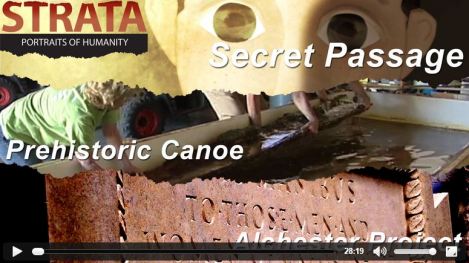 This month we’re pleased to bring you Episode 4 of the new series Strata: Portraits of Humanity, produced by AntiquityNOW’s partner, Archaeological Legacy Institute. In this three-part episode we look at memory and how we preserve the past to remember the lives that were lived so long ago.
This month we’re pleased to bring you Episode 4 of the new series Strata: Portraits of Humanity, produced by AntiquityNOW’s partner, Archaeological Legacy Institute. In this three-part episode we look at memory and how we preserve the past to remember the lives that were lived so long ago.
Part I, “The Secret Passage,” is an animated short about memory found and lost. A young boy and his goat stumble upon an ancient tomb. The boy’s amazement at the find soon turns to horror as he witnesses the reality of looting.
“Weedon Island Canoe” relates the restoration in Pinellas County, Florida, of a 1,000-year-old, 40-foot seafaring canoe. Submerged for three years in a liquid preservative, it is already unlocking secrets to the explorations of Native Americans a millennium ago.
“Alchester Memorial Stone” is Part 3 of this episode of Strata and portrays how the discovery in 2003 of a Roman legionnaire’s gravestone becomes the catalyst for young cadets in Alcester, England, to design a memorial stone for war veterans in their community. Lucius Valerius Geminus was part of the army that first invaded Britain in 43 CE under the Emperor Claudius. He remained in Britain and died at approximately 50 years of age. Long ago his tombstone had been broken up into 20 pieces to become part of a stone wall. Now restored, the tombstone was put on display at the Oxfordshire Museum in Woodstock, UK. The video describes why remembering these soldiers, separated by 2,000 years but united in death, was important to the cadets. As one young man observed, creating the memorial stone “…builds a sense of character and judgment and general understanding of what people have done for the good of others.”
Strata: Portraits of Humanity is a monthly half-hour video series available online and on select cable channels. Strata is a showcase for unique and diverse stories about the world’s cultural heritage. Stories come from across the globe with segments produced by Archaeological Legacy Institute and dozens of producer and distributor partners around the world.
Click on the image below to view the program on The Archaeology Channel and scroll down to see the curriculum developed by AntiquityNOW to accompany Episode 4’s videos.
*Produced in 2014 by Archaeological Legacy Institute, Copyright 2014 by Archaeological Legacy Institute
Lesson Plans
OBJECTIVES
- To introduce students to the concept of cultural heritage and its legacy today
- To demonstrate to students how ancient people developed cultural identity
- To help students gain an understanding of how human culture was able to evolve from ancient to modern times through cultural intersections and shared knowledge
- To appreciate how even in modern times ancient lives can still influence us
- To understand the irrevocable damage of looting and the critical importance of preservation
STUDENT OUTCOMES
- To grasp the importance of cultural preservation by appreciating what we learn from ancient endeavor and how it applies today
- To evaluate and think critically about how civilizations are built upon the ingenuity of those civilizations that preceded them
- To realize how civilizations and the ancient ingenuity that created them don’t die as long as we memorialize our global inheritance.
Lesson Plan 1
The Secret Passage
Project Idea #1
- Explore why there is no dialog in this cartoon. Why do you think the animator made that choice? Write dialog that goes along with the cartoon. How much more or less can you tell your audience about what happens in the video? How does this compare to the cartoon without dialog?
Project Idea #2
- Is this animation appealing to your reason or to your emotions? Write an essay (250-500 words) on how these two persuasive rhetorical styles are used in the cartoon to further the message.
Lesson Plan 2
Weedon Island Canoe
Project Idea #1
- Why do you think these archaeologists and others are putting so much work into restoring this canoe?
- Research how Native Americans explored the seas around what is now Florida. How are the ways their crafts were built unique to their tribe and their location? Make a chart comparing these vessels to two other ancient seafaring cultures from other parts of the world.
Project Idea #2
- Draw a picture or make a clay model of the seafaring vessels made by these ancient people. What common building considerations were made that are still used today (e.g., ease of navigation, waterproofing)?
Lesson Plan 3
Alchester Memorial Stone
Project Idea #1
- Describe what life was like for a Roman soldier in Britain around 43 CE in a series of notes. Add in parentheses your comments on each fact.
- Imagine yourself a soldier. Write a series of diary entries about your time in Britain. Compare it to what your life was like in Rome (e.g., weather, dwellings, entertainment).
- Look up some of the writings of soldiers today. What do the writings have in common? How are they different?
Project Idea #2
- One of the cadets in the video said the memorial stone project was important because it involves “…build(ing) something people will look at for generations and generations.” Why do people memorialize their time on earth?
- Think of an important event in your life. How would you memorialize that on a stone tablet? Would you use pictures? Words? A poem? Create your own memorial stone by drawing or crafting out of clay.







